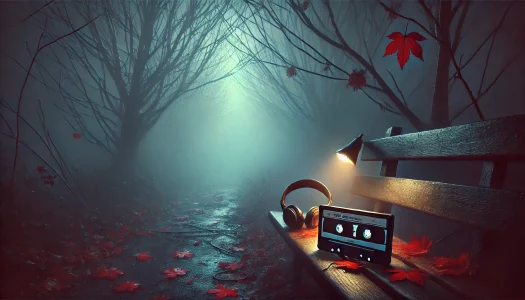Disintegration, The Cure’s 1989 masterpiece, has solidified itself as a quintessential soundtrack for fall—especially October’s dark, introspective nights. With its sweeping, melancholic soundscapes and Robert Smith’s hauntingly poetic lyrics, the album captures the atmospheric weight that seems to linger in the air as days grow shorter and leaves fade. Its enveloping mix of wistful guitars, echoing synths, and hypnotic rhythms forms an immersive listening experience, one that aligns perfectly with autumn’s contemplative aura.
Setting the Scene: 1980s Context and The Cure’s Dark Aesthetic
Released in 1989, Disintegration arrived at the end of a decade that had seen The Cure evolve from post-punk newcomers to gothic rock icons. By the late ‘80s, the band had already established itself as a mainstay in the alternative scene, known for blending shadowy, atmospheric sounds with raw emotional depth. While the mainstream was swept up in polished pop and hair metal, The Cure carved out a distinctive space for darker, introspective music that connected with listeners on a deeply personal level.
Disintegration marked a creative and emotional peak for the band. Themes of melancholy, heartbreak, and existential introspection ran through every track, capturing a sense of longing and isolation that transcended any particular time or place. Songs like “Lovesong,” “Pictures of You,” and “Plainsong” explored these emotions with an unfiltered honesty, resonating with audiences who saw their own reflections in the album’s lyrics and soundscapes.
Its release was initially met with mixed reviews, but over the decades, Disintegration has become revered as an iconic expression of emotional vulnerability and artistic ambition—qualities that have only grown more resonant with time. Today, it stands as a timeless classic, inviting generation after generation to lose themselves in its haunting beauty, especially as autumn’s quiet melancholy settles in.
Sound and Atmosphere: Crafting the Perfect Gloomy Vibe
Disintegration is defined by its expansive, haunting soundscape, a careful layering of echoing guitars, moody synths, and Robert Smith’s unmistakably sorrowful vocals. From the first notes, the album plunges listeners into a lush, atmospheric world where every sound feels like it’s echoing through vast, shadowed spaces. The guitars, drenched in reverb, create a feeling of depth and distance, as if each strum is reverberating through fog. Paired with pulsing, introspective basslines and textured synths, the sound achieves a cinematic quality that’s both otherworldly and deeply intimate.
“Pictures of You” embodies this immersive vibe. The song opens with a hypnotic, winding guitar melody layered over ambient synths, conjuring a sense of longing that feels tailor-made for crisp, overcast October evenings. As the track builds, Smith’s vocals enter softly, like a whispered confession, capturing both heartbreak and nostalgia in every line. Similarly, “Fascination Street” amps up the tension with its driving bassline and relentless beat, creating a darker, more intense atmosphere that’s perfect for the eerie beauty of late autumn. The song’s shimmering synths and tightly coiled guitar riffs lend a sense of urgency and mystery, as though inviting listeners to explore shadowed streets just after twilight.
These sonic elements—sprawling reverb, hypnotic rhythms, and melancholic synth lines—are essential to Disintegration’s “gloomy” aura. Each track feels like a journey through an autumn night, evoking emotions that range from wistful to somber, all the while surrounding the listener in a cocoon of sound that makes for an unforgettable, introspective experience. It’s this rich, atmospheric quality that makes Disintegration an enduring autumn classic, perfectly attuned to the season’s darker moods and reflective undercurrents.
Emotional Resonance: Why the Album Feels Relevant in October
Disintegration resonates so powerfully in October because it taps into universal feelings of nostalgia, loss, and longing—themes that naturally echo the season’s introspective nature. Autumn itself is a time of change, marked by fading light, falling leaves, and the creeping chill that signals the year’s end. This transition evokes a bittersweet mix of reflection and melancholy, a perfect match for the emotional landscape of Disintegration.
At its core, the album explores the fragility of relationships, the ache of memories, and the weight of self-doubt, emotions that Robert Smith captures with striking sincerity. Songs like “Lovesong” convey a longing that’s both deeply personal and universally relatable, while “Pictures of You” is steeped in the kind of nostalgia that emerges when remembering someone from a distance—beautiful, yet filled with the sadness of things past. Each track seems to pull listeners deeper into an emotional state where introspection takes over, a space that’s particularly inviting as fall encourages us to look inward and reconcile with our own memories and regrets.
In October, as the world outside begins to quiet and the air takes on a sense of stillness, Disintegration becomes more than an album—it becomes a companion for navigating the season’s poignant, introspective mood. Its enduring relevance lies in its ability to provide listeners a place to sit with their own thoughts and emotions, allowing them to embrace the full spectrum of fall’s melancholic beauty. Through this connection, Disintegration remains timeless, giving voice to the introspective nature that defines October.
Closing Thoughts
Disintegration endures as a quintessential October album because of its profound themes, haunting atmosphere, and emotional depth. The Cure crafted more than just a collection of songs; they created an immersive soundscape that captures the melancholic beauty of autumn. With its echoing guitars, moody synths, and Robert Smith’s soulful vocals, Disintegration resonates deeply with listeners seeking a soundtrack that mirrors the introspective tone of the season.
As the leaves fall and the days grow shorter, this album remains a perennial companion, allowing listeners to embrace fall’s reflective nature. Whether revisiting old memories or simply soaking in the atmosphere of a chilly October night, Disintegration invites us to linger in its melancholy and find solace in its haunting beauty—a timeless soundtrack for those who find comfort in autumn’s quiet, introspective moments.
